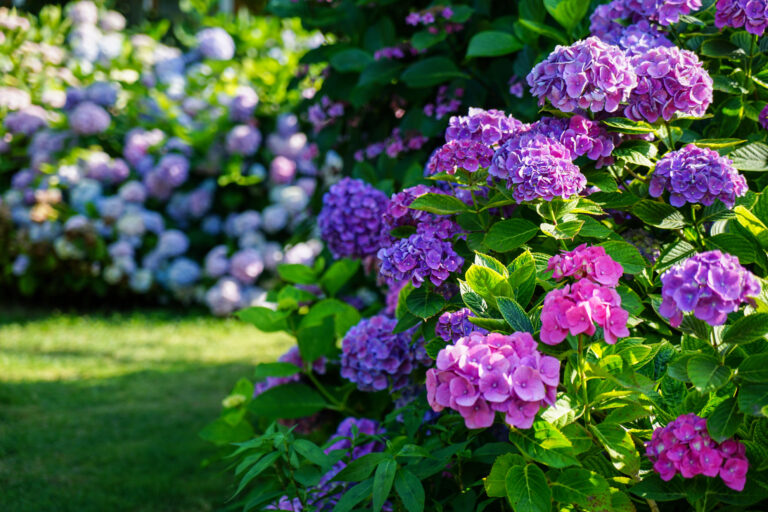Meet the captivating Hydrangea (Hydrangea spp.), a floral wonder that graces gardens worldwide with its timeless beauty. This perennial gem hails from the misty mountains of Japan, where it has been cherished for centuries. Its large, pom-pom-like blooms come in a kaleidoscope of hues, from soft pastels to vibrant blues, pinks, and purples. While its charm may seem ethereal, caring for the Hydrangea can be surprisingly manageable. With a little love and attention, this splendid plant will flourish and reward you with its stunning blossoms year after year.
Common Hydrangea varieties:
- French hydrangea
- Panicled hydrangea
- Smooth hydrangea
- Oakleaf hydrangea
- Hydrangea macrophylla ‘Altona’
- Hydrangea aspera
- Hydrangea paniculata Vanille Fraise
- Hydrangea macrophylla ‘Hamburg
- Penny-mac-hydrangea
Care
If you just started in gardening, no problem at all! Hydrangea plants – just like Hoyas – are not too hard to care for, but there are a few key things to keep in mind:
- Soil: They are adaptable to various soil types but flourish in fertile, humus-rich soil. Play with soil pH to control bloom colors; acidic soil gives blue flowers, while neutral to alkaline soil results in pink blooms.
- Water: Consistent moisture is vital throughout the growing season. Water deeply 1-2 times per week, adjusting based on rainfall. Avoid daily light watering as it won’t reach the roots. In hot weather, increase water but prevent waterlogging.
- Light: They thrive in partial shade with morning sun and afternoon shade to avoid excessive heat. While they can handle full sun, extra watering might be necessary on hot days.
- Temperature: Hydrangeas prefer mild temperatures, avoiding bitter cold and excess winter sun. North or east-facing sites are ideal. They also enjoy moderate to high humidity; dry climates can lead to browning and dry leaves.
Propagation
Being mostly cultivars and hybrids, aren’t typically propagated from seeds. However, two common methods exist to propagate them successfully.
The first involves taking stem cuttings in early fall from light green new growth without flowers. Trim the stem below a leaf node, strip the bottom leaves, dip it in rooting hormone, and place it in a pot with damp soil, creating a mini-greenhouse with a plastic bag. After 2-4 weeks, a root system should develop, and you can transplant it.
The second method involves bending down a long branch into the soil, removing leaves, and securing it with a weight. Once rooted, clip it from the parent plant, ensuring its self-sustainability. Transplanting should be done after a couple more weeks.
Pruning
Hydrangeas are pruned in late winter or early spring, except for climbing hydrangeas, which are pruned after summer flowering.
Dead-heading mophead hydrangeas can be done after flowering or in early spring, while lacecaps are cut back after flowering to prevent seed development.
Established mopheads and lacecaps benefit from cutting out one or two oldest stems to encourage new growth.
Climbing hydrangeas require overlong shoot cutting after flowering to retain top flowers. Other hydrangea species, like paniculata and arborescens, need annual pruning to a framework of branches.
Common pests
Frequently Asked Questions
Hydrangeas often die because they don’t get enough water in the soil. These plants need the soil to stay moist all the time, so if there’s a drought, they can droop or even die. Other reasons for hydrangeas dying include frost damage, shock from transplanting, and getting too much direct sunlight.
Are Hydrangeas toxic to pets?
All parts of hydrangeas, including leaves, buds, flowers, and bark, contain toxins that can make your dog, cat, or horse sick if they munch on them.
When is the best time to plant hydrangeas?
To give your plants the best chance to thrive, aim to plant them in late spring when the risk of frost is gone or in early fall as cooler nights set in. If you live in an area with freezing winters, make sure to get your plants in the ground at least six weeks before the first frost of fall to allow them enough time to establish and settle in before the harsh weather arrives.
How long hydrangeas last?
Hydrangeas can live for many years if they are taken care of properly. With good care, they typically last around 10 to 20 years or even longer (50 years). However, the actual lifespan can vary depending on factors like the type of hydrangea and how well it’s looked after. Some hydrangeas may last for decades, while others might have a shorter life.
Can hydrangeas grow indoors?
It can be a bit tricky to take care of potted hydrangeas given as gifts for indoor enjoyment. They prefer cooler temperatures around 50 to 60 degrees Fahrenheit. If it’s too warm indoors, they might not be as happy. So, it’s a good idea to consider planting them outdoors in your garden for the best results and to ensure they thrive.


